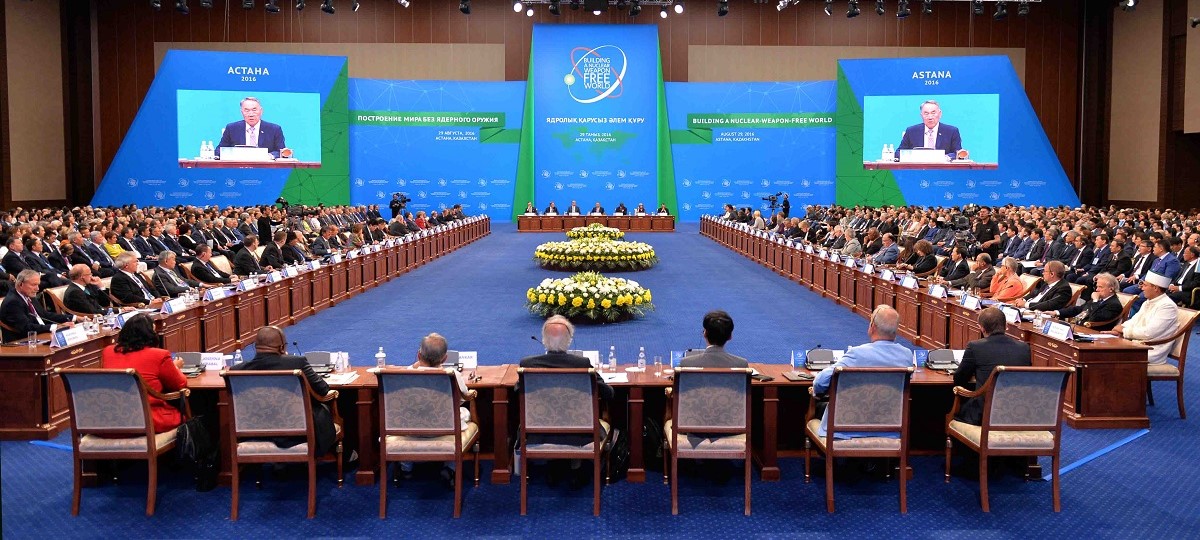[Photo: Astana Conference Building a Nuclear-Weapon-Free World at which the Astana Vision Declaration was adopted].
On 29 August 2016, political and military leaders, legislators, religious leaders, representatives of international organisations, academics, scientists, medical professionals, lawyers, youth, and other representatives of civil society from around the world met in Astana, the capital of Kazakhstan to commemorate the 25th anniversary of the closing of the Soviet nuclear test site in Kazakhstan.
There, they adopted the Astana Vision declaration: From a Radioactive Haze to a Nuclear-Weapon Free World, which draws inspiration from the experience and initiatives of Kazakhstan – a country severely impacted by nuclear weapons and which is now positioning itself as a third party mediator between Russia and the West. The declaration puts forward a plan of 10 actions to help achieve a nuclear weapon-free world.
Kazakhstan & nuclear weapons
In 1991, after the collapse of the Soviet Union, Kazakhstan inherited what was the 4th largest arsenal of nuclear weapons in the world at the time. In one of the most significant steps of nuclear disarmament the world has ever seen, Kazakhstan as an independent state decided to renounce the nuclear weapons entirely and join the nuclear Non-Proliferation Treaty (NPT).
Kazakhstan’s President, Nursaltan Nazarbayev, followed up with a number of other nuclear disarmament initiatives. These included negotiating a Central Asia Nuclear Weapon Free Zone, moving the United Nations to establish August 29 as the International Day Against Nuclear Tests, and drafting a Universal Declaration for a Nuclear Weapon Free World, which has also been adopted by the United Nations.
Barriers to nuclear disarmament
The initiatives from Kazakhstan have been laudable, but have not been able to convince the nuclear-armed States – particularly Russia and the USA, which maintain the largest nuclear stockpiles – to give up their nuclear weapons and negotiate for their global prohibition. Unresolved conflicts and rising tensions in Europe, Asia and the Middle East are causing most nuclear-armed States and their allies to increase their reliance on nuclear deterrence, and to continue to modernize and deploy their nuclear arsenals.
Nuclear disarmament by the nuclear-reliant States is at a standstill – and will be unlikely to commence again unless these States find ways to reduce tensions, build confidence, and resolve (or at least better manage) the conflicts between them.
For this reason, in March this year, President Nazarbayev released a Manifesto: The World. The 21st century, which highlighted the need to shift from military security to common security, enhance war prevention methods, better use conflict resolution mechanisms, make progress on conventional disarmament, and better manage economic competition to ensure a fair economic order. Progress on these would help reduce the role of nuclear weapons and pave the way for global nuclear disarmament.
Astana conference – putting teeth into the manifesto
The Manifesto presents some very sound analysis and worthwhile recommendations of approaches that should be taken. However, it’s unlikely to have much impact unless it motivates key constituencies into effective action. For this reason, one of the principal aims of the August 29th conference in Astana was to evaluate the ideas in the Manifesto, and then develop a concrete action plan of how to move forward with them.
Nuclear disarmament measures
The Astana Vision declaration calls for a range of nuclear disarmament measures, which could be undertaken simultaneously in various forums. These include interim measures by the nuclear-armed States to reduce the risks of nuclear weapons use, supportive measures such as technical work on nuclear disarmament verification, and actions by the UN Security Council and UN General Assembly to prohibit nuclear targeting of populated areas and initiate multilateral nuclear disarmament negotiations.
More significantly, however, are the measures on reducing the role of nuclear weapons in security doctrines, and replacing nuclear deterrence with common security.
Resolving conflicts through common security mechanisms
One point that has been raised time and time again in discussions for nuclear disarmament is the need to reduce and eliminate the role of nuclear weapons in the security doctrines of nuclear states and the allied states. While it is likely true that comprehensive nuclear disarmament will not be feasible until this happens; there has been very little discussion on how this can actually be achieved.
Such a discussion started in Astana and paved the way for action 10 in the Astana Vision Declaration, which highlights ways to achieve security without nuclear weapons by resolving international conflicts through diplomacy, law, regional mechanisms, the United Nations and other peaceful means.
The Astana Vision declaration also notes the role of regional measures to provide security, and simultaneously eliminate the role of nuclear weapons, such as through the establishment of nuclear-weapon-free zones. The declaration calls for further such zones to be established.
From the Prague Vision to the Astana Vision
In his 2009 Prague Speech President Obama announced that: “First, the United States will take concrete steps towards a world without nuclear weapons. To put an end to Cold War thinking, we will reduce the role of nuclear weapons in our national security strategy, and urge others to do the same.”
President Obama followed this up with a Nuclear Posture Review (outlining the new U.S. policy), which affirmed the practice of the non-use of nuclear weapons, emphasized the need to enhance non-nuclear security, and build confidence on the capability to verify the global elimination of nuclear weapons. However, the Obama administration has been unable to convince their own Congress, let alone the rest of the world, that deep conflicts between nuclear-reliant States can be resolved without relying on nuclear deterrence. The Iran deal demonstrates that diplomacy is possible, but the continued conflicts with Russia, North Korea, China, etc. undermine confidence in nuclear disarmament.
It is estimated that the US only dismantled 109 retired warheads in 2015, which is the lowest number recorded since 1970. In 2010 in the US Nuclear Posture Review, the Obama administration announced its aim to “making deterrence of nuclear attack on the United States or our allies and partners the sole purpose of US nuclear weapons”. This seems to have been an empty promise as in accordance with their nuclear doctrine the US reserves the right to use nuclear weapons first in a crisis. Currently the US and Russia both have almost 1000 nuclear missiles each on hair-trigger alert, ready to launch in seconds if early-warning radar shows the country is under nuclear attack.
Clearly there is still much work to be done on developing a security framework that allows states to phase out the use of nuclear weapons in their security doctrines.
Kevin Miletic noted in his speech at the Astana conference that one issue to address is the relationship between conventional disarmament, armed conflict and nuclear disarmament. He noted that although there is a link between these, progress on one should not be contingent on, or have to wait for, progress on the other. On the contrary, taking measures on conventional disarmament (and/or war prevention) could help nuclear disarmament and vice-versa. .
He explained that, in order to make progress in phasing out nuclear deterrence, “we have to constructively address this delicate relationship and develop a sound counterargument with a view to reconciling conventional and nuclear disarmament.” The example he presented is that of New Zealand who, as a member of the Western nuclear alliance in the 1950s-80s, was drawn into various wars (Korea, Malaya and Vietnam) and maintained conventional military forces suitable for attacking other countries. In 1987, New Zealand abolished nuclear weapons, which altered their perceptions and policies on conventional weapons and war.
They replaced reliance on nuclear deterrence with reliance on the United Nations and international law. This ensured that they only participated in military actions sanctioned by the UN, such as UN Peacekeeping. It also assisted in the resolution of conflicts in New Zealand’s favour through the UN, such as against the French acts of terrorism in New Zealand and the French nuclear tests in the Pacific.
The Costa Rica example
Costa Rica also offers us an excellent example of a highly evolved security doctrine that does not rely on nuclear weapons, or any use of force at all. Costa Rica is part of a nuclear weapon free zone and does not have the military means to defend itself against external aggression. Manuel A. Gonzalez (Minister of Foreign Affairs in the Costa Rican Ministry of Foreign Relations and Worship) discussed in his speech how Costa Rica has pushed for nuclear disarmament since the abolition of its army in 1948. Since then, they have held a firm belief in “negotiation between states and the international law as Costa Rica’s defense doctrines and has promoted disarmament in all areas, including the recent Arms Trade Treaty.”
This was put to the test when they experienced conflicts with Nicaragua over territorial claims around the San Juan River. Nicaragua moved armed troops into the area to which they laid claim. Costa Rica, without a standing military force, did not respond in kind. Instead Costa Rica took its case to the International Court of Justice who eventually ruled in their favour and Nicaragua was forced to withdraw their troops and accept Costa Rica’s claim to the land. This serves as a great example of the way some states security doctrines have been able to evolve in such a way that violence is unnecessary and they no longer put the lives of millions of innocent citizens at risk.
Conclusion:
The Astana Vision is a step out of the disarmament standstill we face today. It relies on cooperation between civil society representatives, governments and international organisations to find a way out of the current radioactive haze and forge a nuclear weapon-free world. The conference participants developed a concrete action plan for governments to finally step away from a reliance on these weapons. This declaration goes beyond identifying the risks of nuclear-reliance doctrines, and offers realistic and achievable measures to phase out nuclear deterrence.
The future of humanity depends on the choices world leaders make concerning these weapons. Stepping away from the nuclear deterrence framework is a daunting task, and leaders are drowning in the treacherous political tides. The Astana Vision is nothing short of a life-line, offering a way back from the dark road we are headed.
By Rachel Day, Research Officer, Parliamentarians for Nuclear Non-proliferation and DisarmamentNike Air Zoom Pegasus

